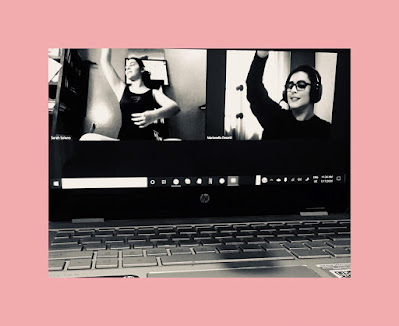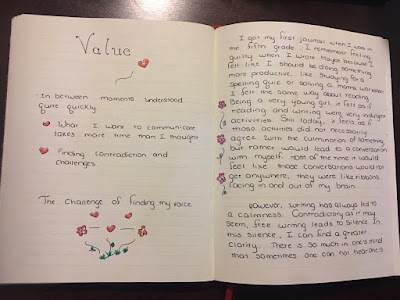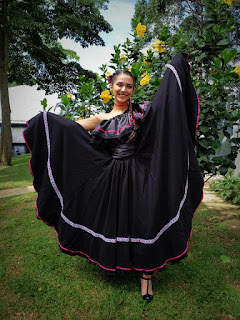Marianella Desanti Dance, MAPP Middlesex University London, Student Blog
Thursday, October 19, 2023
Creativity and Choreographic Collaboration
Monday, May 30, 2022
Healing Through The Arts
Saturday, July 25, 2020
On Discovering Dance Teaching as an Art Form
Discovering Dance Teaching as an Art Form
I had been teaching dance for years systematically and mechanically and until a series of experiences would shake this practice at the very core. I started an intellectual and practical exploration and I discovered that teaching dance was, unquestionably, art.
I had been distracted at first with class structure and methodology. I think most dance teachers are. I was absolutely obsessed with correcting technical imperfections.
Lost in the challenge of dance proficiency, of liberating from error.
Then
a moment of perfect artistry and inspiration happened in my classroom. I saw it flicker in my students' eyes. Dancers suspended in beauty
and time forever. The spell broken, the struggle and hard work return,
yet the dancer forever changed- the human vulnerable but louder and stronger.
Another day, it happened again. As Picasso would have described in his
own words, the inspiration was real and found us working. Through
reflection I discovered that the moment of artistic explosion had been created
by a delicate sequence of stimulating exercises, sensations, patterns, and
experiences. A perfect connection between mental exploration and the
embodiment of dance artistry.
I
started working harder. I started diving deeper and began creating a dance
class based on experiential learning beyond teacher direction. The dance and exercises in a structured
sequence lead the dance student to work on technique delicately woven into
artistic experimentation. Time created for class sections incorporated
and repeated. And repeated.
The
class carefully crafted and the dance technique a vehicle for exploration in
itself. The physical rigour when worked on through careful timing and
understanding leads to a meditative state of higher cognitive awareness.
True learning through discovery, feeling and physical challenges... And through
this process I now see my dancers become. I become witness to an artistry
and dancing evolve beyond my own as my students colour and texture their
learning to a unique voice and expression.
I
stand forever changed. I stand overwhelmed with a feeling of connection,
of heightened awareness, of grandeur and smallness, and trembling sensitivity
that only inspiration confers. I stand humbled. An artist
discovering a new vehicle and challenge to my creativity. A dance teacher
discovering, exploring, transforming the mundane work of the class into dance
art.
Saturday, July 18, 2020
Of a New Dream, Of Dance Renewed
Aspiring Ballerina Julianna Solano in ballet class
Recently a beautiful, young and aspiring ballerina has joined as a new student of mine.
It was promptly evident that this student has bigger dreams than most, dreams of joining the professional world of dance as a dancer and teaching artist. Such a life project of hers fills me with hope and joy as another dancer dares to dream big.
I have lately been
thinking of the things I want to communicate to my student as she transforms into
the artist she seeks to become. Some
seemed so important that I thought it would be better to write them down. Here are those thoughts, transformed into a
letter.
Dear Julianna,
Thank you for including me as part of your adventure as your dance teacher, I confess I will learn much from this process too.
These are my guiding thoughts to
share with you as we move forward.
Dance as if you were never to be
able to dance again.
Be grateful for every step, every
breath, every dance.
Be grateful to your body.
Beauty comes from a place of
love.
Be humble to learn,
But grand in your dance.
Own your space
Fill it with the greatness of
your spirit
Honour the vitality of your soul.
Be brave,
Be bold,
Be unapologetic.
Be powerful as a great Olympian
And delicate and sensitive as the
youngest child.
Listen to the critics
In their criticism you will find
the key to your growth.
But be deaf to those that predict
your failure,
They are not God, they do not
know.
Ignore the snobs,
Be patient with the ignorant
To dance is to be forever
vulnerable.
Make everything an opportunity
for learning.
Nothing is ever a failure,
Unless you quit, unless you stop
dancing.
Only then would you fail, and
only then.
The most successful dancer is the
most resilient.
Whatever life did not give you as
a gift in talent,
You can develop and enjoy as a
gift from hard work.
Find your beauty.
Do not be afraid to feel.
Own the moment.
Find the stillness in the
movement.
Quiet in music
Peace in the challenge of battle.
Find your voice
Discover your pathway
Love yourself with all your imperfections
Celebrate life, love and dance in
every single moment.
No matter how old you become
And how much gray comes to replace
your youth…
Do not ever stop dancing
Dance in the living room
In the kitchen
In the hall
In the garden under the sun and
the open sky
Be strong Julianna,
May you always find the Song and Joy of your Dance.
Julianna Solano, aspiring ballerina
Thursday, November 21, 2019
On Finding My Voice
Wednesday, November 6, 2019
Our Afro-Caribbean Dance and Soul

Thursday, October 24, 2019
Costa Rican Folklore Dance and Early Childhood Education
I have attended several national and international art festivals such as the “Festicers Les Enfants du Monde” in France and the FEA in Costa Rica, also dance competitions, congresses and presentations in various theatres in our country.
My goal is to bring art to as many children and young people as possible, teach them that through music and dance people can acquire discipline and motivation; they can express different feelings and above all, show them that they can, in a physical and mental way, develop many skills. It would be a tool from which they can balance their lives and find a way to cope with difficult situations.
Creativity and Choreographic Collaboration
I studied extensively to become a dancer. I was a dance student for so long that I do not remember ever not being a dance student- I was a ...

-
I studied extensively to become a dancer. I was a dance student for so long that I do not remember ever not being a dance student- I was a ...
-
On Sunday we had a lovely class discussion at our Middlesex University London evening class. It was on the topic of finding one’s voice of...
-
Photograph by Adriana Porras with Mariana Solano, ballerina. Both my ballet students, from a photo session in the studio with me. Discoveri...
-
Costa Rican Folklore Folklore and Creative Movement Dance Teacher Valeria Chavarria during her formative years. As a danc...
-
Aspiring Ballerina Julianna Solano in ballet class Recently a beautiful, young and aspiring ballerina has joined as a new student of mine. ...
-
Have you ever felt like your struggling a little bit and can not really pinpoint why? Have you ever felt indescribable joy and wish you coul...
-
Claudio Taylor and Costa Rican Children's Folklore Ballet (Ballet Folklórico Infantil de Costa Rica) This is the story of how...
-
This is the beginning of the end of my studies at Middlesex University London, as a student of the master’s in Dance Technique Pedagogy. ...
-
Dancing with Danza Libre Today my classmates and I from the Masters in Dance (I am a MAPP candidate in Dance Pedagogy and Technique) ...
-
As I read through the blogs of my classmates in the MAPP Dance programme of Middlesex University of London, I read about their own process t...






























